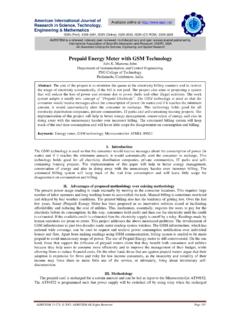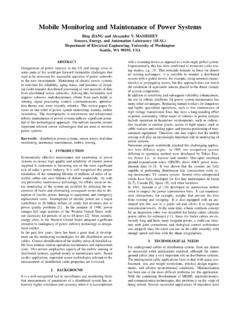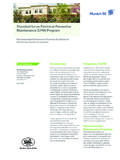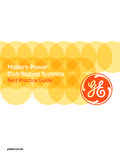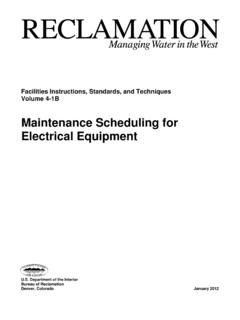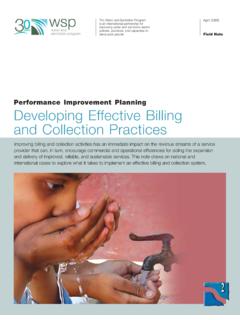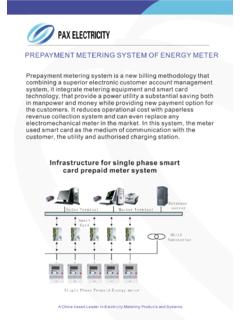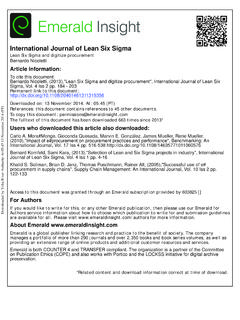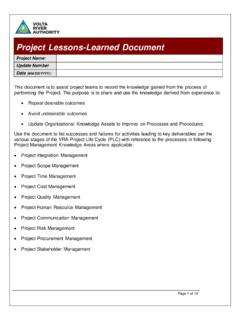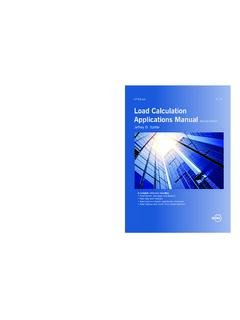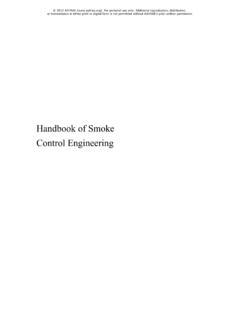Transcription of Evaluating Public Relations - Volta River Authority
1 PR IN PRACTICE SERIESL ondon and PhiladelphiaEvaluating PublicRelationsTom Watson and Paul NobleA Best Practice Guide to Public Relations Planning, Research and EvaluationSecond Edition Evaluation in Public Relations Rev prelims:Evaluation in PR 13/7/07 14:46 Page iPublisher s noteEvery possible effort has been made to ensure that the information contained inthis book is accurate at the time of going to press, and the publishers and authorscannot accept responsibility for any errors or omissions, however caused. Noresponsibility for loss or damage occasioned to any person acting, or refrainingfrom action, as a result of the material in this publication can be accepted by theeditor, the publisher or either of the published in Great Britain and the United States in 2005 by Kogan PageLimitedSecond edition 2007 Apart from any fair dealing for the purposes of research or private study, or criti-cism or review, as permitted under the Copyright, Designs and Patents Act 1988,this publication may only be reproduced, stored or transmitted, in any form or byany means, with the prior permission in writing of the publishers, or in the case ofreprographic reproduction in accordance with the terms and licences issued by theCLA.
2 Enquiries concerning reproduction outside these terms should be sent to thepublishers at the undermentioned addresses:120 Pentonville Road525 South 4th Street, #241 London N1 9 JNPhiladelphia PA 19147 United Tom Watson and Paul Noble, 2005, 2007 The right of Tom Watson and Paul Noble to be identified as the authors of thiswork has been asserted by them in accordance with the Copyright, Designs andPatents Act 978 0 7494 4979 7 British library Cataloguing-in- publication DataA CIP record for this book is available from the British of congress cataloging -in- publication DataWatson, Tom, 1950 Evaluating Public Relations : a best practice guide to Public Relations planning,research & evaluation / Tom Watson & Paul Noble. -- 2nd bibliographical references and : 978-0-7494-4979-7 ISBN-10: 0-7494-4979-91.
3 Public Relations --Evaluation. 2. Public Relations --Evaluation--Case studies. , Paul, 1955 II. by Jean Cussons Typesetting, Diss, NorfolkPrinted and bound in India by Replika Press Ptv LtdEvaluation in Public Relations Rev prelims:Evaluation in PR 13/7/07 14:46 Page ii1 Principles of Public Relations practice1 The role of theory 2; The evolution of Public Relations 3;Practice paradigm 4; Defining Public Relations 5; Publicrelations theory 7; Grunig s primacy 7; Europeanperspectives 82 Evaluation and communication psychology12 Number one practitioner topic 16; Objectives ofevaluation 17; Complexity of evaluation 18;Methodology problems 19; Effects-based planning 20;Defining evaluation 21; Principles of evaluation 233 Practitioner culture why we do what we do28 Holy Grail or reinventing the wheel 28; Bean counters v creativity 30; Large-scale studies 31.
4 Lindenmann sresearch 32; Watson s studies 35; Australian studies 36;Small sample research 38; CEO s attitudes 44; Multiplemetrics 45; The barriers to evaluation 45; Pressures toevaluate 46; CIPR policy statement 47; Conclusions 494 Gathering and interpreting information53 The scope of research 57; Research methods 60; Deskresearch 61; Action research 63; Case studies 64;Experiments 65; Surveys 66; Interviews 67;Questionnaires 70; Sampling methods 72;Questionnaire design 73; Analysing information 75 ContentsEvaluation in Public Relations Rev prelims:Evaluation in PR 13/7/07 14:46 Page iii5 Evaluation structures and processes81 Preparation, Implementation, Impact 82; Macnamara sPyramid Model 84; Public Relations EffectivenessYardstick 86; The PRE process 88; The Unified model 92;Practitioner-derived models 94; Short Term andContinuing programmes 96; Universality ofapplication 99; Dashboards and scorecards 1016 Developing a media evaluation system107 Setting up a simple media monitoring system 107;A dimensional model of media evaluation 125;Case study: in-house media evaluation system 1297 Evaluation in practice case studies139 PricewaterhouseCoopers 139; Airbus 141; Comalco 143;Infocomm Development Authority of Singapore 145;LIFT06 Conference 148; Southwest Airlines 151; SurreyPolice 154; Toyota Australia 155; Westminster CityCouncil, London 156; Volvo XC90 1598 Objectives and objective setting164 Objectives in context 164; Aims, goals and objectives 167;Management by objectives (MBO) 169; Hierarchy ofobjectives 171; Specifying objectives 174.
5 The natureof objectives 177; Process objectives 1809 Relationship and crisis communication measurement186 Measuring relationships 186; Evaluating communicationseffectiveness in a crisis 19210 The challenge of the online environment198 Public Relations online 198; Evaluating websitesand online press offices 206; Media evaluation andthe net 210; A cyberspace toolbox 21211 Future developments216 Developing good practice 217; Return on Investment(ROI) 222; Econometrics 228; Advertising ValueEquivalents (AVEs) 230; Payment by results 232;Management overview 234; Moving evaluationforward 237; Top tips for Evaluating Public Relations 238 References244 Further reading250 Index251iv ContentsEvaluation in Public Relations Rev prelims:Evaluation in PR 13/7/07 14:46 Page ivIn this chapter, evaluation is introduced and set in the historicalperspectives of Public Relations evolving practice.
6 The nature andextent of Public Relations theory are explored and definitions ofpublic Relations are discussed. Definitions of evaluation anddescription of key practices complete the any group of PR practitioners around the world to list themajor issues facing their discipline, and it is almost certain that evalu-ation of PR activity will be ranked very highly, if not the number onetopic. The measurement of activity and outcomes has many facetswhich will be described throughout this book. To set the context ofevaluation, the theory and debate over the discipline of Public rela-tions need to be explored. For some practitioners, theory is stuff thatgets in the way of doing PR . Yet theory is developed from observedpractice and helps predict outcomes.
7 This, in turn, gives greaterstrength to practitioners in developing robust campaigns. Evaluationhelps them define campaigns, monitor their progress and provideevidence of outcomes. So theory and sound evaluation practices canand should go of publicrelations practiceEvaluating Public Relations Rev 1-138: Evaluating PR 13/7/07 14:48 Page 1 THE ROLE OF THEORYP ublic Relations is a relatively new professional activity that is stilldeveloping its body of knowledge and theoretical approaches. Atpresent, the role that theory plays in Public Relations practice islimited. As practice expands worldwide, the demand for greateragreement on concepts, embodied in models and theory, is expectedto grow, if only for reasons of clarity of communication from onenation to adoption of the scientific research process for the study ofpublic Relations issues and problems offers many advantages to prac-titioners in the creation of effective campaigns and other Public rela-tions activities.
8 Robustly researched theories offer prediction,understanding and replication. Prediction gives greater assurance toplanning and execution of activities and a practitioner could, there-fore, buttress his or her professional experience with the applicationof relevant theory to explain that, if a certain course of action isfollowed, it is likely that certain consequences may follow. That apractitioner can apply proven theory will help in the making of intel-ligent practical decisions . When there is a lack of theory, it is exceed-ingly difficult to create a consistent decision-making methodology foruse in planning and evaluation, let alone make predictions onoutcomes of Public Relations Relations practice is in the humanistic, social science frame-work and therefore unlike the more precisely measured naturalsciences.
9 Because Public Relations activity uses a multiplicity of com -muni cations techniques, it does not operate in isolation (as would anatural science experiment in a laboratory) from other communica-tions influences and so concepts and theories are likely to be based onobserved practice. However, predictive understanding has alreadybeen identified as an important value of theory for use by the practi-tioner. Whether objective knowledge can be obtained, in the style ofnatural science, is a challenge for future research programmes. Atpresent, it is most probable that understanding based on observationis likely to create the path forward for Public Relations theory as it hasdone for much of social science (see, in particular, the discussion ofaction research in Chapter 4).
10 Practitioners are often closely involved in the mechanics of theiractivities and need to develop a structured understanding of theissues they are influencing in order to understand the attitudes ofothers. They also need the rigour of predictive understanding toverify logically the phenomena (such as publics, communities andmedia) with which they plan to is another attribute of theory that has value for2 Evaluating Public relationsEvaluating Public Relations Rev 1-138: Evaluating PR 13/7/07 14:48 Page 2planning of Public Relations programmes. If theory provides clearguidance to explain and predict phenomena of interest to us , thetheory should be applicable in many similar situations. It can thus bereplicated in practice and in future research Public Relations , the methodology of the scientific researchprocess in its social sciences form offers the opportunity to createmodel theory that can be applied to current practice.
